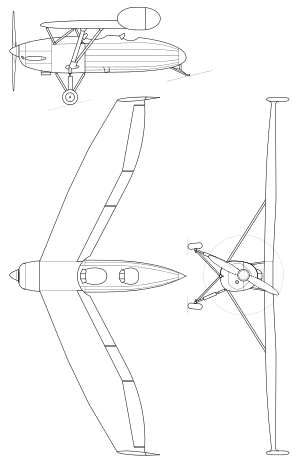DFS 193
The DFS 193 was a planned experimental German aircraft of the 1930s planned by Deutsche Forschungsanstalt für Segelflug (DFS). Designed by Professor Alexander Lippisch and a DFS employee named Roth, it resembled Lippisch's Storch IX and the Gotha Go 147.
| DFS 193 | |
|---|---|
 | |
| Role | Unbuilt and unflown experimental aircraft |
| National origin | Germany |
| Manufacturer | Deutsche Forschungsanstalt für Segelflug |
Design and development
The DFS 193 was a two-seat tailless aircraft designed to explore the military potential of this layout. It was powered by an Argus As 10 C, of 240 hp (179 kW). Although a mockup was tested in a wind tunnel in 1936, it was abandoned in 1938 because it did not show any improvement over traditional designs.[1] The aircraft was therefore never built.
Specifications
Data from The Delta Wing: History and Development[1]
General characteristics
- Crew: two
- Length: 5.97 m (19 ft 7 in)
- Wingspan: 11.06 m (36 ft 3 in)
- Height: 3.1 m (10 ft 2 in)
- Wing area: 17.08 m2 (183.8 sq ft)
- Empty weight: 750 kg (1,653 lb)
- Max takeoff weight: 1,065 kg (2,348 lb)
- Powerplant: 1 × Argus As 10 C 8-cylinder, air-cooled, 90° inverted Vee piston aircraft engine, 180 kW (240 hp)
Notes
- Lippisch, Alexander (1981). The Delta wing: development and history. Iowa State University Press.
gollark: ???
gollark: It would be more accurate to say *a* next round.
gollark: It's not exactly "brought in" from "unaffiliated servers" if it originates here and is affecting events here.
gollark: Also², it is correcting the at least *misleading* if not *wrong* statements.
gollark: Also relevant to the ongoing events.
References
| Wikimedia Commons has media related to DFS 193. |
- Nowarra, Heinz J. (1993). Die Deutsche Luftrüstung 1933-1945 (in German). Koblenz, Germany: Bernard & Graeffe Verlag. ISBN 3-7637-5464-4.
- Pawlas, Karl R. Luftfahrt-Lexikon (in German).
This article is issued from Wikipedia. The text is licensed under Creative Commons - Attribution - Sharealike. Additional terms may apply for the media files.